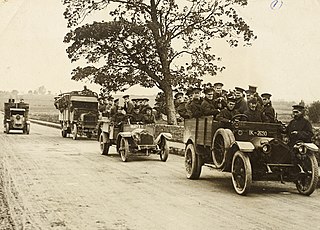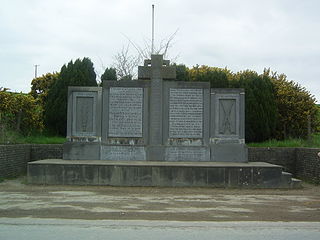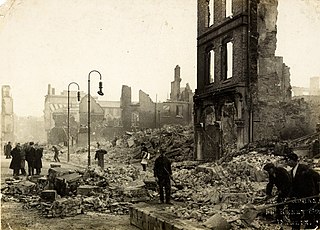
The Black and Tans were constables recruited into the Royal Irish Constabulary (RIC) as reinforcements during the Irish War of Independence. Recruitment began in Great Britain in January 1920, and about 10,000 men enlisted during the conflict. The majority were unemployed former British soldiers from England, Scotland and Wales who had fought in the First World War. Some sources count Irish recruits to the RIC from 1920 as "Black and Tans."

Tom Maguire was an Irish republican who held the rank of commandant-general in the Western Command of the Irish Republican Army (IRA) and led the South Mayo flying column.

The Irish War of Independence, also known as the Anglo-Irish War, was a guerrilla war fought in Ireland from 1919 to 1921 between the Irish Republican Army and British forces: the British Army, along with the quasi-military Royal Irish Constabulary (RIC) and its paramilitary forces the Auxiliaries and Ulster Special Constabulary (USC). It was part of the Irish revolutionary period.

The Auxiliary Division of the Royal Irish Constabulary (ADRIC), generally known as the Auxiliaries or Auxies, was a paramilitary unit of the Royal Irish Constabulary (RIC) during the Irish War of Independence. It was founded in July 1920 by Major-General Henry Hugh Tudor and made up of former British Army officers, most of whom came from Great Britain and had fought in the First World War. Almost 2,300 served in the unit during the conflict. Its role was to conduct counter-insurgency operations against the Irish Republican Army (IRA), acting mainly as a mobile striking and raiding force. It operated semi-independently of the RIC and was mainly deployed to southern and western regions where fighting was heaviest.
The Carrowkennedy ambush was an ambush carried out by the Irish Republican Army (IRA) on 2 June 1921, during the Irish War of Independence. An IRA flying column, commanded by Michael Kilroy, ambushed a mobile patrol of the Royal Irish Constabulary including Black and Tans recruits at Carrowkennedy, near Westport, County Mayo. It resulted in the deaths of seven of the RIC, including some who were killed by their own rifle grenade. After two hours the RIC surrendered and their weaponry and ammunition were seized by the IRA.

This is a timeline of the Irish War of Independence of 1919–21. The Irish War of Independence was a guerrilla conflict and most of the fighting was conducted on a small scale by the standards of conventional warfare.

The Crossbarry ambush, also known as the Battle of Crossbarry, occurred on 19 March 1921 and was one of the largest engagements of the Irish War of Independence. It took place near the small village of Crossbarry in County Cork, about 20 km south-west of Cork city. About a hundred Irish Republican Army (IRA) volunteers, commanded by Tom Barry, escaped an attempt by about 1,200 British troops to encircle them. During the hour-long battle, ten British troops and three IRA volunteers were killed.
The Coolavokig ambush was carried out by the Irish Republican Army (IRA) on 25 February 1921, during the Irish War of Independence. It took place at Coolavokig, on the road between Macroom and Ballyvourney, County Cork. A 60-man flying column of the IRA's 1st Cork Brigade under Seán O'Hegarty, ambushed a 70-man convoy of the Auxiliary Division under Major Seafield Grant, sparking a four-hour battle. Ten Auxiliaries were killed, including Major Grant, and others wounded. The IRA column left the area when British reinforcements arrived. After the ambush, British forces stopped carrying out raids and patrols in the area.
The Scramoge ambush was an ambush carried out by the Irish Republican Army (IRA) on 23 March 1921, during the Irish War of Independence. The IRA ambushed a lorry carrying British troops and Royal Irish Constabulary (RIC) officers at Scramoge, near Strokestown in County Roscommon. Three British soldiers and an RIC officer were killed, while two RIC 'Black and Tans' were captured and shot dead shortly after.
The Clonfin Ambush was an ambush carried out by the Irish Republican Army (IRA) on 2 February 1921, during the Irish War of Independence. It took place in the townland of Clonfin between Ballinalee and Granard in County Longford. The IRA ambushed two lorries carrying members of the British Auxiliary Division, sparking a lengthy gun battle in which four Auxiliaries were killed and eight wounded. The Auxiliaries eventually surrendered and their weapons were seized. The IRA commander, Seán Mac Eoin, won some praise for helping the wounded Auxiliaries. Following the ambush, British forces burned a number of houses and farms in the area, and shot dead an elderly farmer.
The Selton Hill ambush took place on 11 March 1921, during the Irish War of Independence. An Irish Republican Army (IRA) flying column was ambushed by members of the RIC Auxiliary Division at Selton Hill, County Leitrim. Six IRA members of the South Leitrim Brigade were killed, which effectively destroyed the IRA in South Leitrim.
The Sheemore ambush was an ambush carried out by the Irish Republican Army (IRA) on 4 March 1921, during the Irish War of Independence. It took place at Sheemore near Carrick-on-Shannon, County Leitrim.
The Burgery ambush was an ambush carried out by the Irish Republican Army (IRA) on 18–19 March 1921, during the Irish War of Independence. It took place near Dungarvan, County Waterford.

Michael Kilroy was an Irish republican and politician. He was an Irish Republican Army (IRA) officer in his native County Mayo during the Irish War of Independence and Irish Civil War. Subsequently, he was a Sinn Féin and later Fianna Fáil Teachta Dála (TD) for Mayo South.

The burning of Cork, by British forces, took place during the Irish War of Independence on the night of 11–12 December 1920. It followed an Irish Republican Army (IRA) ambush of a British Auxiliary patrol in the city, which wounded twelve Auxiliaries, one fatally. In retaliation, the Auxiliaries, Black and Tans and British soldiers burned homes near the ambush site, before looting and burning numerous buildings in the centre of Cork, Ireland's third-biggest city. Many Irish civilians reported being beaten, shot at, and robbed by British forces. Firefighters testified that British forces hindered their attempts to tackle the blazes by intimidation, cutting their hoses and shooting at them. Two unarmed IRA volunteers were also shot dead at their home in the north of the city.

The Headford Ambush was carried out by the Irish Republican Army (IRA) on 21 March 1921, during the Irish War of Independence. The IRA's 2nd Kerry Brigade ambushed a train carrying British troops of the Royal Fusiliers at Headford Junction railway station near Killarney, County Kerry. This sparked a battle lasting almost an hour, in which at least 13 people were killed – nine British soldiers, two IRA volunteers and three civilians. The IRA withdrew after another train carrying British troops arrived.
The Clonmult ambush took place on 20 February 1921, during the Irish War of Independence.
The Dromkeen ambush took place on 3 February 1921, during the Irish War of Independence, at Dromkeen in County Limerick. The Irish Republican Army (IRA) ambushed a Royal Irish Constabulary (RIC) patrol, killing 11 policemen.
The Kilmeena ambush was an action during the Irish War of Independence that took place at Kilmeena, County Mayo on 19 May 1921. The ambush ended in defeat for the local West Mayo Irish Republican Army (IRA), with five IRA volunteers killed and four wounded and captured. Two members of the Royal Irish Constabulary (RIC) and one Black and Tan were also killed in the action.
The siege of Tralee was an event that took place between 1 and 9 November 1920 in Tralee, County Kerry, Ireland.








